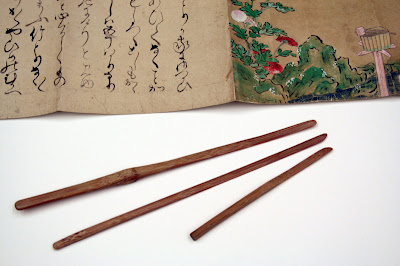The hand scrolls measuring just over 29.0 metres, had a number of different types of paper joints within their structure. Whilst the original sheet sizes of the papers used had a bearing on where joints occurred, there are also different types of joints used between the various lining papers. A straight knife cut edge for example would provide a strong but less smooth joint, whereas a water torn paper edge would be smoother (and as a consequence roll better). So, as part of the examination of the hand scrolls we had carefully noted the position and the types of all the joins in the scrolls.
 |
| Fine bamboo spatulas (hera) which are used for dry separation of paper linings |
We then had to decide the least disruptive way of separating these. The most effective is often, where possible, to separate the sections without moisture using a very thin spatula made for this purpose out of a special type of bamboo. Traditionally the best for spatulas (hera) is soot bamboo (susu dake) which is very hard.
We were very pleased to welcome Dr Michael Ryan, Director of the Chester Beatty Library who visited the Restorient studio last week. We talked through progress to date and outlined our schedule for the coming months.
It was very interesting for us to hear more of the history of this extraordinary collection formed by Sir Alfred Chester Beatty. He was an American, who made his fortune mining in the Rocky Mountain district of Denver, Colorado. He was often called "The King of Copper".


